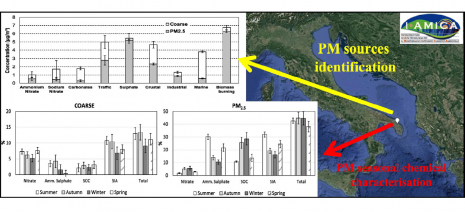Seasonal variability of PM2.5 and PM10 composition and sources in an urban background site in Southern Italy
j F Y in Uncategorized
D. Cesari a,⁎, G.E. De Benedetto b, P. Bonasoni c, M. Busetto c, A. Dinoi a, E.Mericoa, D. Chirizzi b, P. Cristofanelli c, A. Donateo a, F.M. Grasso a, A.Marinoni c, A. Pennetta b, D. Contini a
a Istituto di Scienze dell’Atmosfera e del Clima, ISAC-CNR, 73100 Lecce, Italy; b Dipartimento di Beni Culturali, Università del Salento, 73100 Lecce, Italy; c Istituto di Scienze dell’Atmosfera e del Clima, ISAC-CNR, 40129 Bologna, Italy
Science of the Total Environment 612 (2018) 202–213

Comparison of fine and coarse fractions in terms of sources and dynamics is scarce in southeast Mediterranean countries; differences are relevant because of the importance of natural sources like sea spray and Saharan dust advection, because most of the monitoring networks are limited to PM10. In this work, the main seasonal variabilities of sources and processes involving fine and coarse PM (particulate matter) were studied at the Environmental-Climate Observatory of Lecce (Southern Italy). Simultaneous PM2.5 and PM10 samples were collected
between July 2013 and July 2014 and chemically analysed to determine concentrations of several species:
OC (organic carbon) and EC (elemental carbon) via thermo-optical analysis, 9 major ions via IC, and 23 metals via ICP-MS. Data was processed through mass closure analysis and Positive Matrix Factorization (PMF) receptor model characterizing seasonal variabilities of nine sources contributions. Organic and inorganic secondary aerosol accounts for 43% of PM2.5 and 12% of PM2.5–10 with small seasonal changes. SIA (secondary inorganic aerosol) seasonal pattern is opposite to that of SOC (secondary organic carbon). SOC is larger during the cold period, sulphate (the major contributor to SIA) is larger during summer. Two forms of nitrate were identified: NaNO3, correlated with chloride depletion and aging of sea-spray, mainly present in PM2.5–10; NH4NO3 more abundant in PM2.5. Biomass burning is a relevant source with larger contribution during autumn and winter because of the influence of domestic heating, however, is not negligible in spring and summer, because of the contributions of fires and agricultural practices.Mass closure analysis and PMF results identify two soil sources: crustal associated to long range transport and carbonates associated to local resuspended dust. Both sources contributes to the coarse fraction and have different dynamics with crustal source contributing mainly in high winds from SE conditions and carbonates during high winds from North direction.






